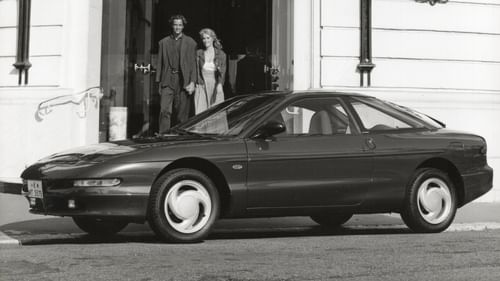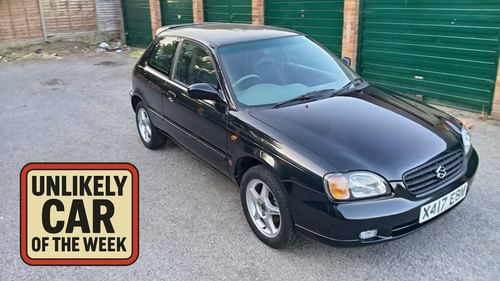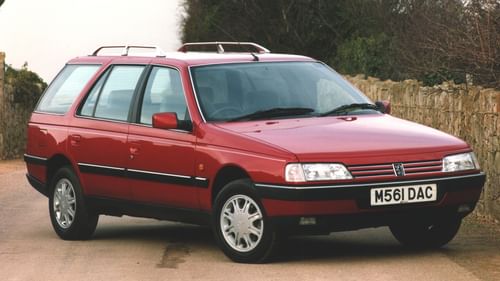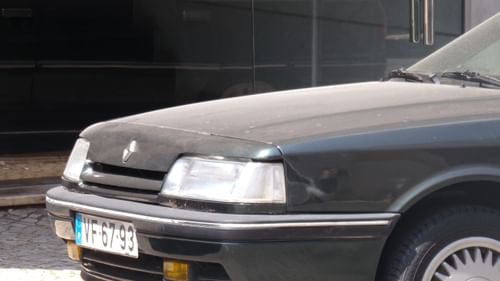Wolfsburg’s technicolour dreamboat: Volkswagen Polo Harlequin
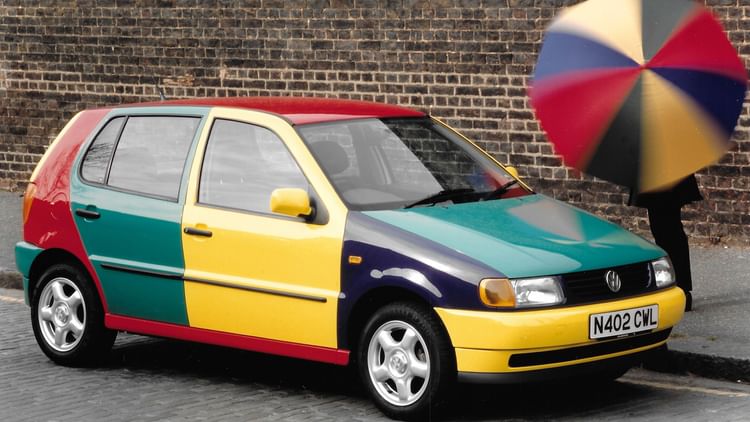
‘We don’t make mistakes; we have happy accidents.’ Not our words, but the words of Bob Ross, the chap whose prodigious perm graced the world of painting. We’ll never know what Ross would have made of the Polo Harlequin – the American painter died in July 1995, just months before VW’s multi-coloured hatchback debuted at the Frankfurt motor show – but we reckon he would have approved of Wolfsburg’s happiest of accidents.
The Polo Harlequin has been a mainstay of best/worst/weirdest/maddest/strangest [delete as applicable] special edition car lists for 27 years, having made the unlikely transition from sales tool to production model. Loved and loathed in equal measure, the Harlequin – defined by the Cambridge Dictionary as ‘a humorous character in plays at the theatre, especially in the past, who wears brightly coloured clothes with a diamond pattern’ – is a car for extroverts and those who find modern car colours a little too predictable. If you want to tip-toe through a Gloucestershire village without drawing attention to yourself, don’t buy a Polo Harlequin.
It might be one of the most colourful cars of the 20th century, but the origins of the prismatic Polo are more prosaic. The story starts with the launch of the third-generation (6N) Polo in 1994, a car for which adjectives like ‘solid’, ‘dependable’ and ‘robust’ were invented. What Car? labelled it ‘a class leader whose supremacy seems destined to last’, before naming it 1995 Car of the Year. After some initial reservations, Autocar liked the Polo enough to include it in its list of the top ten cars of 1995. It called out the members of the European Car of the Year jury for placing the Fiat Punto ahead of the Polo, before concluding: ‘To call the new Volkswagen a scaled-down Golf is not to damn it with faint praise but to credit it with big-car abilities that all superminis seek but few attain.’
It would become the small car of choice for everyone from doting dads in search of something safe for their daughters to pensioners downsizing to something that retained an air of prestige. For the first time, the Polo was initially available with three and five doors; there were four trim levels, from L to GLX; a range of engines; and, in 1995, Open Air and saloon versions, the latter being a badge-engineered Seat Cordoba. The Polo itself shared a platform with the Seat Ibiza, a car that beat the VW to market.

So far, so mildly interesting, but nothing to suggest that the Mk3 Polo would go on to let its grey hair down and reach for the Schwarzkopf. Indeed, aside from cabriolet and hot versions of the Golf, the VW range was short on excitement and entertainment. Cars for staying at home and singing the blues, not going out and painting the town red.
If you’ll excuse the intentional tip of the hat to another Polo special edition, there was nothing remotely exciting about the Harlequin’s genesis. It was borne out of a basic sales tool, known as Das-Polo-Baukasten-System (The Polo modular system), highlighting a new ‘building block’ concept of buying a new Polo on the continent, rather than the UK’s familiar trim level approach. There were four segments, each one given a distinct colour: blue for engine and chassis, yellow for interior, red for special equipment, and green for paintwork. These coloured blocks were designed to promote the Polo’s strapline of ‘So vielseitig konn klein sein’, or ‘Small can be so versatile’.
That would have been the end of the Harlequin story, if it weren’t for a group of meddling trainees in Wolfsburg, who in 1994 had the idea of creating a fleet of ten multi-coloured Polos to showcase the modular system far better than any brochure could do. A further ten followed in 1995, with the finished cars, complete with mismatched wheels, appearing in German dealer literature, consumer adverts and on phonecards; Volkswagen even produced 1000 1:87 scale models.

Sensing an opportunity – and armed with the reassurance of numerous enquiries from colour-me-curious punters – VW’s marketing bods created a Polo Harlequin – or Harlekin in Europe – for the 1995 Frankfurt motor show, where its brightness even managed to overshadow the glittering launch of the Mitsubishi Carisma. Volkswagen Germany and its dealers were inundated with enquiries for the United Colours of What Were They Thinking? Polo, with a market study suggesting there was sufficient demand for a full production model. These days, Volkswagen’s Twitter account would be awash with replies featuring the Futurama ‘Shut up and take my money’ gif, but in 1995 it had to rely on telephone calls, showroom footfall and the odd fax. ‘Sei ruhig und nimm mein Geld,’ as they say in Germany.
Volkswagen promised that it would readily take people’s readies if a thousand orders were placed, and with the commitment from customers, it pressed ahead with a run of 1000 cars, complete with consecutive serial numbers, certificates and numbered key rings. That could have – maybe, should have – been the end of it; a strictly limited edition European special, as colourful as a Swatch watch and with a sunny outlook rivalled only by a song penned by Ian Broudie.
Then it made a marvellous appearance at the 1995 London Motor Show, flanked by a Polo Open Air and Golf GTI, and within view of a Sharan atop a turntable. On a sombre and sober stand, the Harlequin stood out like a novelty tie on a grey suit. Mr Blobby’s zaniness to Noel’s oh-so-tidy beard.
The show car’s Flash Red sills, rear three-quarter panels and roof marked it out as a ‘Version 4’ Harlequin. These sections lack the interchangeability of the other sections of the Polo’s body, so the final colour scheme isn’t quite as random as it would first appear. Indeed, there were just four versions, each one based on the car’s original colour when it left the production line, either Flash Red (Flashrot), Chagall Blue (Chagallblau), Yellow (Ginstergelb) or Pistachio Green (Pistazie-grün). The remaining panels were configured in a way that meant you could see all four colours, regardless of the angle. Customers were unable to specify a colour combo, with VW promoting this as ‘an element of surprise’. In truth, it was probably due to the company not wanting to be left with a surplus of body shells and panels in Wolfsburg. The biggest element of surprise was arguably reserved for the moment when the customer arrived at the VW showroom to discover that, yes, they really did tick the box marked ‘Harlequin’. Good for them; life’s too short to buy boring cars; we’ve had our fill of grey, silver and black cars, and worrying about resale values.

Buoyed by London’s reaction to the Harlequin show car, VW pressed ahead with plans to build a right-hand drive version. It went on sale in 1996, with VW UK electing to use the car’s origins as a reason for its existence. In a press ad featuring a ‘Version 3’ car and headlined by ‘No, honestly,’ it said: ‘This isn’t a product of our imagination, it’s a product of the Volkswagen plant in Wolfsburg. The Harlequin, as it’s called, started life as a car show gimmick to indicate the colours available. Of course, the orders flooded in. We dutifully started producing the multi-coloured mavericks, each with a colourful array of features.’ If you’re not imagining John Peel introducing a new track by ‘The Multi-coloured Mavericks’, you should be.
Based on the five-door 1.4 CL, the Harlequin cost £11,095, or £20,750 in today’s money. Interestingly, that’s the current price for an entry-level Polo Life, which isn’t available with multi-coloured panels. Come on, Volkswagen, sort your Life out…
According to PoloDriver.com, just 113 Harlequins were sold in the UK, which would suggest that we’re not quite as daring as our friends across the Channel. Several Harlequin fan sites quote a figure of 3806 for total production, which includes the initial batch of 1000 numbered examples and 500 raffled in a German McDonald’s promotion. A couple of sources quote a figure of 3100, but it’s fair to assume that more than three-thousand Europeans fancied a colourful slice of VW history.
According to DVLA figures, there are 25 Harlequins taxed and tested in the UK, with a further 34 registered as SORN. Assuming the cars listed as off the road are roadworthy, a 52 percent survival rate is pretty good. Beware of imitations, because fake Harlequins do exist. The real deal should feature bespoke fabric covering the sports seats, driver’s airbag, GLX ‘sports’ bumpers, clear indicator lenses, darkened rear lenses, 14-inch ‘Indianapolis’ alloy wheels, blue leather steering wheel, special gear knob, Sony stereo system and a ‘Harlequin’ decal on the back. Options included a sunroof, CD player, ABS and air conditioning. The vehicle colour should also be noted as ‘Multi-Colour’ on the V5C.

‘P472 UDG’ is a proper Harlequin; a ‘Version 1’ with Yellow sills, rear three-quarter panels and roof. It wouldn’t be more 1990s if it arrived with a swagger, sporting a Britpop haircut, and swigging from a bottle of Hooch. If the look Volkswagen was hoping to nail was ‘multi-panel rugby shirt from the back pages of a Sunday supplement’, it can consider the Harlequin to be a job well done. The passing of time may have lessened the shock of being in the presence of VW’s kaleidoscopic curio, but the oddness of seeing multiple colours when you open the doors remains a spectacle. The front door hinges are a prime example, being flanked by Yellow, Flash Red and Pistachio Green.
Unfortunately, the cabin is a bit of an anti-climax. The blue steering wheels reeks of a few quid spent in a Carnoisseur catalogue (not necessarily a bad thing), but the ‘Harlekin’ gear knob is a neat touch. The seat fabric, described by Volkswagen as ‘chirpy’, looks like it was inspired by a bottle of L’Oréal Studio Line hair gel. Again, that’s not a bad thing, but could Wolfsburg have gone further? A set of coloured floor mats, one for each exterior hue, could have been fitted at a dealer with no impact on the production line. Other visual treats, like a coloured glovebox lid, colourful gearstick and handbrake gaiters, and door cards to match one of the exterior colours could have worked. Gaudy, yes, but have you seen the outside? Maybe the sight of a blue steering wheel, Pistachio Green door mirrors and a Chagall Blue bonnet is enough optical stimulation for the driver.

Which is just as well because the driving experience is less memorable than the paintwork. It behaves like you’d expect a Mk3 Polo to behave, which means tidy handling, a slightly detached feel from the road and a reluctance to be hurried. The 1.4-litre engine, which replaced the ancient 1.3-litre lump in 1995, produces 59bhp, enough for a 0-60mph time of 14.9 seconds. It feels even slower than that, not helped by the angry engine note and a general sense that the interior plastics are trying to escape from the cabin.
It's not fun to drive, but that was never really the point of the Harlequin. Ideas like this rarely make it beyond the boardroom; dismissed as being too adventurous and off-brand. This was Volkswagen shaking off its corporate straitjacket and sticking on a coat of many colours. We should be pleased it took a punt on its happy accident. As Bob Ross said, ‘We want happy paintings. Happy paintings. If you want sad things, watch the news.’ We’ll drink to that, Bob.
Photos courtesy of Volkswagen and Magic Car Pics. Tip of the hat to Richard Gooding of PoloDriver.com for the archive material and fact-checking.
This article first appeared in issue 23 of Classic.Retro.Modern. magazine.

